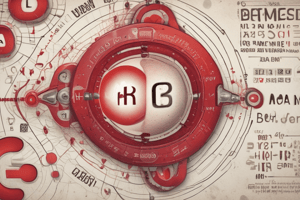Podcast
Questions and Answers
What is the primary isotype of naturally occurring antibodies?
What is the primary isotype of naturally occurring antibodies?
- IgE
- IgA
- IgM (correct)
- IgG
How can IgM antibodies bind to specific antigens or pathogens?
How can IgM antibodies bind to specific antigens or pathogens?
- Requiring T cell activation.
- Only after the host has been exposed to the antigen.
- Exclusively to antigens present in the host's own cells.
- Even if the host has never been exposed to the antigen. (correct)
To what kind of structures are many antibodies reactive?
To what kind of structures are many antibodies reactive?
- Structures common to many species, such as nucleic acids and phospholipids. (correct)
- Unique structures found only in specific pathogens.
- Structures altered by genetic modification.
- Structures only found in the host organism's cells.
What determines a person's blood group?
What determines a person's blood group?
Which process is initiated by the binding of antibodies to erythrocytes?
Which process is initiated by the binding of antibodies to erythrocytes?
What is the effect of agglutination on erythrocytes?
What is the effect of agglutination on erythrocytes?
What is the outcome of antibodies binding to multiple erythrocytes simultaneously?
What is the outcome of antibodies binding to multiple erythrocytes simultaneously?
In the context of blood groups, what do surface antigens on erythrocytes determine?
In the context of blood groups, what do surface antigens on erythrocytes determine?
Which of the following is a characteristic of natural antibodies?
Which of the following is a characteristic of natural antibodies?
What is the composition of blood group antigens?
What is the composition of blood group antigens?
What triggers a hemolytic reaction?
What triggers a hemolytic reaction?
How does agglutination of erythrocytes contribute to cell damage?
How does agglutination of erythrocytes contribute to cell damage?
What is a key characteristic of antigens found on cell surfaces?
What is a key characteristic of antigens found on cell surfaces?
Which event immediately precedes pore formation in erythrocytes during a hemolytic reaction?
Which event immediately precedes pore formation in erythrocytes during a hemolytic reaction?
What is the role of IgM antibodies in immunity?
What is the role of IgM antibodies in immunity?
If agglutination leads to pore formation and cell death, what broader immunological process does this describe?
If agglutination leads to pore formation and cell death, what broader immunological process does this describe?
How does the structure of blood group antigens contribute to their function?
How does the structure of blood group antigens contribute to their function?
How do antibodies recognize antigens on the erythrocyte cell surface?
How do antibodies recognize antigens on the erythrocyte cell surface?
What is the significance of antibodies being able to bind to multiple erythrocytes at the same time?
What is the significance of antibodies being able to bind to multiple erythrocytes at the same time?
Which of the following accurately describes the relationship between agglutination and hemolytic reactions?
Which of the following accurately describes the relationship between agglutination and hemolytic reactions?
In an individual with type B blood, which antibodies are present in their plasma?
In an individual with type B blood, which antibodies are present in their plasma?
Why does the immune system react to donor cells in an ABO-incompatible transfusion?
Why does the immune system react to donor cells in an ABO-incompatible transfusion?
What is the consequence of administering type B blood to a recipient with type A blood?
What is the consequence of administering type B blood to a recipient with type A blood?
What antibodies are present in the plasma of a person with type O blood?
What antibodies are present in the plasma of a person with type O blood?
If a patient with type A blood receives a transfusion of type AB blood, why might this cause a problem?
If a patient with type A blood receives a transfusion of type AB blood, why might this cause a problem?
Which blood type is considered a 'universal recipient' due to the absence of anti-A or anti-B antibodies in their plasma?
Which blood type is considered a 'universal recipient' due to the absence of anti-A or anti-B antibodies in their plasma?
What is the term used to describe antigens on erythrocytes that can sometimes cause agglutination?
What is the term used to describe antigens on erythrocytes that can sometimes cause agglutination?
A patient with type O blood requires a blood transfusion. Which blood type(s) can they safely receive?
A patient with type O blood requires a blood transfusion. Which blood type(s) can they safely receive?
What is the immunological consequence of administering incompatible donor blood that leads to hemolysis?
What is the immunological consequence of administering incompatible donor blood that leads to hemolysis?
In an emergency transfusion, why is type O blood often considered the 'universal donor'?
In an emergency transfusion, why is type O blood often considered the 'universal donor'?
What antigens and antibodies are present in a person with type AB blood?
What antigens and antibodies are present in a person with type AB blood?
Why is administering type A blood to a person with type O blood problematic?
Why is administering type A blood to a person with type O blood problematic?
In ABO blood grouping, which genotype corresponds to the presence of both A and B antigens on the erythrocyte surface?
In ABO blood grouping, which genotype corresponds to the presence of both A and B antigens on the erythrocyte surface?
If a recipient with type B blood receives type A blood, what immediate immunological reaction is expected?
If a recipient with type B blood receives type A blood, what immediate immunological reaction is expected?
Under what circumstances is a hemolytic transfusion reaction most likely to occur?
Under what circumstances is a hemolytic transfusion reaction most likely to occur?
Why do individuals with type AB blood lack both anti-A and anti-B antibodies?
Why do individuals with type AB blood lack both anti-A and anti-B antibodies?
Why is it generally less problematic if a recipient with type A blood receives a small amount of type B blood compared to the reverse situation?
Why is it generally less problematic if a recipient with type A blood receives a small amount of type B blood compared to the reverse situation?
In blood transfusions, what is the role of antibodies reacting with antigens on foreign erythrocytes?
In blood transfusions, what is the role of antibodies reacting with antigens on foreign erythrocytes?
What is the outcome when antibodies in the plasma react with antigens on transfused erythrocytes?
What is the outcome when antibodies in the plasma react with antigens on transfused erythrocytes?
What characteristic of IgG antibodies is particularly relevant in the context of pregnancy?
What characteristic of IgG antibodies is particularly relevant in the context of pregnancy?
How does the presence or absence of the D antigen relate to Rh blood type?
How does the presence or absence of the D antigen relate to Rh blood type?
What is the clinical significance of the Kell antigen system in Caucasians, considering the prevalence of the K allele?
What is the clinical significance of the Kell antigen system in Caucasians, considering the prevalence of the K allele?
Considering the two proteins responsible for Rh serotypes, how are the C and E antigens related?
Considering the two proteins responsible for Rh serotypes, how are the C and E antigens related?
What is the primary structural feature of the Kell antigen?
What is the primary structural feature of the Kell antigen?
How do amino acid substitutions in the Kell glycoprotein contribute to different Kell antigen types?
How do amino acid substitutions in the Kell glycoprotein contribute to different Kell antigen types?
After the ABO and Rh systems, what is the next most clinically significant blood group system?
After the ABO and Rh systems, what is the next most clinically significant blood group system?
Considering the Rh system, why is the D antigen considered the most important?
Considering the Rh system, why is the D antigen considered the most important?
How do anti-Kell antibodies typically mediate red blood cell destruction?
How do anti-Kell antibodies typically mediate red blood cell destruction?
If a pregnant woman lacks the K antigen and her fetus inherits the K antigen from the father, what is the potential immunological consequence?
If a pregnant woman lacks the K antigen and her fetus inherits the K antigen from the father, what is the potential immunological consequence?
What characteristic differentiates IgG antibodies from other antibody isotypes, allowing them to cross the placenta, thus affecting fetal immunity?
What characteristic differentiates IgG antibodies from other antibody isotypes, allowing them to cross the placenta, thus affecting fetal immunity?
Which of the following blood group systems is most likely to cause hemolytic disease of the fetus and newborn (HDFN)?
Which of the following blood group systems is most likely to cause hemolytic disease of the fetus and newborn (HDFN)?
How does the structure of the Kell glycoprotein influence its role in red blood cell antigenicity?
How does the structure of the Kell glycoprotein influence its role in red blood cell antigenicity?
Why is the D antigen in the Rh system considered highly antigenic?
Why is the D antigen in the Rh system considered highly antigenic?
If a patient requires a blood transfusion and has anti-Kell antibodies, which type of blood is safe to transfuse?
If a patient requires a blood transfusion and has anti-Kell antibodies, which type of blood is safe to transfuse?
How does knowledge of Kell antigen prevalence in specific populations guide transfusion practices?
How does knowledge of Kell antigen prevalence in specific populations guide transfusion practices?
Which property makes IgG antibodies capable of causing hemolytic disease of the fetus and newborn (HDFN)?
Which property makes IgG antibodies capable of causing hemolytic disease of the fetus and newborn (HDFN)?
What is the primary mechanism by which anti-Kell antibodies cause red blood cell destruction?
What is the primary mechanism by which anti-Kell antibodies cause red blood cell destruction?
How does the genetic variability within the Kell blood group system contribute to the complexity of blood transfusions?
How does the genetic variability within the Kell blood group system contribute to the complexity of blood transfusions?
Which of the following best describes the antigens of the Rh blood group system that are of clinical importance?
Which of the following best describes the antigens of the Rh blood group system that are of clinical importance?
What genetic characteristic is associated with the Duffy blood group system?
What genetic characteristic is associated with the Duffy blood group system?
What is the primary function of the Duffy glycoprotein in the context of malarial infections?
What is the primary function of the Duffy glycoprotein in the context of malarial infections?
Which of the following best describes the transfusion reactions associated with the Duffy blood group system?
Which of the following best describes the transfusion reactions associated with the Duffy blood group system?
How does the absence of Duffy antigens (a-b- phenotype) impact susceptibility to malaria?
How does the absence of Duffy antigens (a-b- phenotype) impact susceptibility to malaria?
How many alleles are associated with the Duffy blood group system?
How many alleles are associated with the Duffy blood group system?
What is the significance of the N- and C-termini locations, in relation to the cell membrane, in the Kidd glycoprotein structure?
What is the significance of the N- and C-termini locations, in relation to the cell membrane, in the Kidd glycoprotein structure?
Which characteristic is associated with the Kidd blood group system?
Which characteristic is associated with the Kidd blood group system?
What structural feature is characteristic of the Kidd glycoprotein?
What structural feature is characteristic of the Kidd glycoprotein?
How does the number of antigens relate to amino acid substitutions in the Kidd blood group system?
How does the number of antigens relate to amino acid substitutions in the Kidd blood group system?
What function does the glycoprotein associated with the Kidd blood group system perform?
What function does the glycoprotein associated with the Kidd blood group system perform?
In a population where the incidence of a+b+ is 50% and a+b- is 25% for the Kidd system, what can be inferred about the distribution of the Jk(a) and Jk(b) alleles?
In a population where the incidence of a+b+ is 50% and a+b- is 25% for the Kidd system, what can be inferred about the distribution of the Jk(a) and Jk(b) alleles?
If a patient with no Duffy antigens receives blood containing Duffy antigens in a transfusion, what is the most likely immunological consequence?
If a patient with no Duffy antigens receives blood containing Duffy antigens in a transfusion, what is the most likely immunological consequence?
Considering genetic variations within the Duffy blood group system, how does this affect the development of vaccines against malaria?
Considering genetic variations within the Duffy blood group system, how does this affect the development of vaccines against malaria?
How does the presence of 10 transmembrane spanning domains in the Kidd glycoprotein influence its function as a urea transporter?
How does the presence of 10 transmembrane spanning domains in the Kidd glycoprotein influence its function as a urea transporter?
What would be the most appropriate initial step in managing a patient experiencing a delayed hemolytic transfusion reaction due to Kidd antibodies?
What would be the most appropriate initial step in managing a patient experiencing a delayed hemolytic transfusion reaction due to Kidd antibodies?
How does the location of the N-glycosylation site on the Kidd glycoprotein contribute to its function?
How does the location of the N-glycosylation site on the Kidd glycoprotein contribute to its function?
Why are transfusion reactions involving Kidd system antibodies often delayed?
Why are transfusion reactions involving Kidd system antibodies often delayed?
Which of the following scenarios poses the greatest risk of a severe hemolytic transfusion reaction related to the Kidd blood group system?
Which of the following scenarios poses the greatest risk of a severe hemolytic transfusion reaction related to the Kidd blood group system?
What is the expected outcome if a individual with a rare silent Jk allele receives a transfusion of Jk(a+b+) blood?
What is the expected outcome if a individual with a rare silent Jk allele receives a transfusion of Jk(a+b+) blood?
Flashcards
Surface antigens
Surface antigens
Red blood cells carry these which determine blood type.
IgM antibody binding
IgM antibody binding
IgM antibodies bind to particular antigens or pathogens, even if the host has never been exposed to it before.
Effect of agglutination
Effect of agglutination
Agglutination causes pore formation in the cell membrane, leading to cell death.
Agglutination
Agglutination
Signup and view all the flashcards
Antibody recognition
Antibody recognition
Signup and view all the flashcards
Natural antibodies
Natural antibodies
Signup and view all the flashcards
Reactive groups
Reactive groups
Signup and view all the flashcards
Agglutinins
Agglutinins
Signup and view all the flashcards
Type A blood
Type A blood
Signup and view all the flashcards
Type B blood
Type B blood
Signup and view all the flashcards
Type AB blood
Type AB blood
Signup and view all the flashcards
Type O blood
Type O blood
Signup and view all the flashcards
Incompatible transfusion
Incompatible transfusion
Signup and view all the flashcards
Hemolytic transfusion reaction
Hemolytic transfusion reaction
Signup and view all the flashcards
Serum Antibodies
Serum Antibodies
Signup and view all the flashcards
Rhesus (Rh) System
Rhesus (Rh) System
Signup and view all the flashcards
Rh D Antigen
Rh D Antigen
Signup and view all the flashcards
C/E Antigens
C/E Antigens
Signup and view all the flashcards
Rhesus Antibodies (IgG)
Rhesus Antibodies (IgG)
Signup and view all the flashcards
Kell System
Kell System
Signup and view all the flashcards
AA Substitutions in Kell
AA Substitutions in Kell
Signup and view all the flashcards
Kell Antigens
Kell Antigens
Signup and view all the flashcards
Kell system importance
Kell system importance
Signup and view all the flashcards
Anti-Kell Antibodies
Anti-Kell Antibodies
Signup and view all the flashcards
K allele
K allele
Signup and view all the flashcards
Duffy System
Duffy System
Signup and view all the flashcards
Kidd System
Kidd System
Signup and view all the flashcards
Duffy Glycoprotein Function
Duffy Glycoprotein Function
Signup and view all the flashcards
a-b- Phenotype
a-b- Phenotype
Signup and view all the flashcards
Duffy System Transfusion Reactions
Duffy System Transfusion Reactions
Signup and view all the flashcards
Kidd System Transfusion Reactions
Kidd System Transfusion Reactions
Signup and view all the flashcards
Study Notes
- Duffy glycoprotein involves a single amino acid substitution.
- There are two alleles A and B in the Duffy system.
- 70% of African Americans and 100% of West Africans are a-b-.
- Duffy glycoprotein is the receptor that enables penetration of the malarial parasite into erythrocytes.
- The a-b- phenotype confers resistance to malaria.
- Duffy antibodies typically result in a moderate, delayed transfusion reaction.
- In the UK, the incidence of Duffy phenotypes are: a+b- (20%), a+b+ (46%), and a-b- (34%).
- The Kidd system involves 3 antigens represented by a single amino acid substitution.
- The Kidd antigen is present on a glycoprotein with 10 transmembrane spanning domains.
- The glycoprotein has cytoplasmic N- and C- termini, and 1 extracellular N-glycosylation site and acts as a urea transporter.
- Kidd antibodies can cause severe acute hemolytic transfusion reactions, but are often delayed after transfusion.
- In the UK, the incidence of Kidd phenotypes are: a+b- (25%), a+b+ (50%), and a-b+ (25%).
Studying That Suits You
Use AI to generate personalized quizzes and flashcards to suit your learning preferences.




